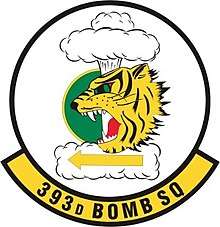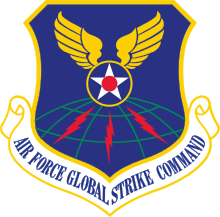393d Bomb Squadron
| 393d Bomb Squadron | |
|---|---|
.jpg) 393d Bomb Squadron B-2 Spirit on approach for landing[note 1] | |
| Active | 1944–1990; 1993–present |
| Country |
|
| Branch |
|
| Role | Strategic Bombing |
| Part of | Air Force Global Strike Command |
| Garrison/HQ | Whiteman Air Force Base |
| Engagements |
World War II Kosovo War Global War on Terrorism[1] |
| Decorations |
Air Force Outstanding Unit Award with Combat "V" Device Air Force Meritorious Unit Award Air Force Outstanding Unit Award Republic of Vietnam Gallantry Cross with Palm[1] |
| Insignia | |
| 393d Bomb Squadron emblem (approved 15 July 1957)[1] |
 |
| 393d Bombardment Squadron emblem (approved 19 December 1944)[2][3] |
.png) |

The 393d Bomb Squadron is part of the 509th Bomb Wing at Whiteman Air Force Base, Missouri. It operates Northrop Grumman B-2 Spirit nuclear-capable strategic bomber aircraft.
The 393d Bombardment Squadron is the only United States Air Force squadron to carry out a nuclear attack on an enemy in combat. During World War II, its aircraft attacked Hiroshima on 6 August 1945 and Nagasaki, Japan 9 August 1945 with atomic bombs.
History
Activated as a Boeing B-29 Superfortress squadron in early 1944; trained under Second Air Force. Due to a shortage of B-29s, the squadron was initially equipped with former II Bomber Command Boeing B-17 Flying Fortresses previously used for training heavy bomber replacement personnel as engineering flaws were being worked out of the B-29. The squadron was then reassigned for advanced training and received B-29s at Fairmont Army Air Field, Nebraska during the late spring and summer of 1944.
509th Composite Group
In December 1944 reassigned as the only operational B-29 squadron to 509th Composite Group at Wendover Field, Utah in December. Aircraft were refitted to Silverplate configuration becoming atomic bomb capable under a highly classified program. Deployed to North Field (Tinian) in late May 1945, flying non-combat missions practicing atomic bomb delivery techniques. The squadron carried out two Atomic Bombing missions over Japan in August 1945, being the only squadron in the world to ever carry out and deliver nuclear weapons in combat. Dropped the first atomic bomb on Hiroshima, Japan, on 6 August 1945, and the second atomic bomb on Nagasaki, Japan, on 9 August 1945.
Reassigned to the United States in November 1945, becoming part of Continental Air Forces (later Strategic Air Command). Deployed to Kwajalein in 1946 to carry out Operation Crossroads atomic bomb tests on Bikini Atoll in July.
Strategic Air Command
Began upgrading to the new Boeing B-50 Superfortress, an advanced version of the B-29 in 1949. The B-50 gave the unit the capability to carry heavy loads of conventional weapons faster and farther as well as being designed for atomic bomb missions if necessary. Squadron deployed to SAC airfields in England, and also to Andersen Air Force Base, Guam on long-term deployments in the 1950s.
By 1951, the emergence of the Soviet Mikoyan-Gurevich MiG-15 interceptor in the skies of North Korea signaled the end of the propeller-driven B-50 as a first-line strategic bomber. Received new, swept wing Boeing B-47 Stratojets in 1955 which were designed to carry nuclear weapons and to penetrate Soviet air defenses with its high operational ceiling and near supersonic speed. The squadron flew the B-47 for about a decade when by the mid-1960s it had become obsolescent and vulnerable to new Soviet air defenses. The squadron began to send its stratojets to AMARC at Davis-Monthan Air Force Base, Arizona for retirement in 1965.
Was scheduled for inactivation however instead received Boeing B-52D Stratofortresses in 1965. It rotated aircraft and crews to Andersen Air Force Base, Guam in support of Southeast Asia Operation Arc Light operations between 1966 and 1969. Not operational, Nov 1969–Jun 1971. Re-equipped with General Dynamics FB-111 nuclear capable medium bomber in 1970; operated until retirement in 1990.
It was reactivated in 1993 as first operational Northrop Grumman B-2 Spirit stealth bomber squadron.
Operations and decorations
- Combat operations: Combat in Western Pacific, 1 Jul – 14 Aug 1945. Only squadron trained for atomic warfare in World War II Participated in atomic bomb tests on Bikini Atoll, Jul 1946, while deployed on Kwajalein. Rotated aircraft and crews to Andersen AFB, Guam, in support of Southeast Asia Operations, 1966–1969.
- Campaigns: World War II: Air Offensive, Japan; Eastern Mandates; Western Pacific. Vietnam War; Global War on Terror.
- Decorations: Air Force Outstanding Unit Awards: Apr – 1 Oct 1968; 1 Jul 1977 – 30 Jun 1979; 1 Jul 1981 – 30 Jun 1982; 1 Jul 1982 – 30 Jun 1984; 1 Jul 1988 – 30 Jun 1990. Republic of Vietnam Gallantry Cross with Palm: 5 Mar – 14 Oct 1969.
Lineage
- Constituted as the 393d Bombardment Squadron, Very Heavy on 28 February 1944
- Activated on 11 Mar 1944
- Redesignated 393d Bombardment Squadron, Medium on 2 July 1948
- Redesignated 393d Bombardment Squadron, Heavy on 2 April 1966
- Redesignated 393d Bombardment Squadron, Medium on 1 December 1969
- Inactivated on 30 September 1990
- Redesignated 393d Bomb Squadron on 12 March 1993
- Activated on 27 August 1993[1]
Assignments
- 504th Bombardment Group, 11 March 1944
- Second Air Force, 25 November 1944
- 509th Composite Group (later 509th Bombardment Group), 17 December 1944 (attached to 509th Bombardment Wing, 17 November 1947 – 14 Sept 1948 and after 1 February 1951)
- 509th Bombardment Wing, 16 June 1952 – 30 September 1990[note 2]
- 509th Operations Group, 27 Aug 1993– present[1]
Stations
- Dalhart Army Air Field, Texas, 11 March 1944
- Fairmont Army Air Field, Nebraska, 12 March 1944
- Wendover Field, Utah, 14 September 1944 – 26 April 1945
- North Field, Tinian, 30 May–17 October 1945
- Roswell Army Air Field (later Walker Air Forcee Base), New Mexico, 6 November 1945
- Deployed to Bucholz Army Airfield, Kwajalein, Marshall Islands, 1 May–July 1946; RAF Mildenhall, England, 4 June–2 September 1952; Andersen Air Force Base, Guam, 18 June–c. 18 September 1953 and 10 July–8 October 1954; RAF Upper Heyford, England, 26 January–30 April 1956
- Pease Air Force Base, New Hampshire, 1 July 1958 – 30 September 1990
- Whiteman Air Force Base, Missouri, 27 August 1993 – present[1]
Aircraft
|
|
See also
References
Notes
- Explanatory notes
- ↑ Aircraft is Northrop Grumman B-2 Spirit AV-5, serial 82-1070 "Spirit of Ohio" during a Red Flag Exercise at Nellis Air Force Base, Nevada.
- ↑ Probably attached to Twentieth Air Force, 18 June–c. 18 September 1953.
- Citations
Bibliography
![]()
- Endicott, Judy G. (1998). Active Air Force Wings as of 1 October 1995 and USAF Active Flying, Space, and Missile Squadrons as of 1 October 1995 (PDF). Air Force History and Museums Program. Washington, DC: Office of Air Force History. ASIN B000113MB2. Retrieved July 2, 2014.
- Maurer, Maurer, ed. (1983) [1961]. Air Force Combat Units of World War II (PDF) (reprint ed.). Washington, DC: Office of Air Force History. ISBN 0-912799-02-1. LCCN 61060979. Retrieved December 17, 2016.
- Maurer, Maurer, ed. (1982) [1969]. Combat Squadrons of the Air Force, World War II (PDF) (reprint ed.). Washington, DC: Office of Air Force History. ISBN 0-405-12194-6. LCCN 70605402. OCLC 72556. Retrieved December 17, 2016.
- Ravenstein, Charles A. (1984). Air Force Combat Wings, Lineage & Honors Histories 1947-1977 (PDF). Washington, DC: Office of Air Force History. ISBN 0-912799-12-9. Retrieved December 17, 2016.
- Watkins, Robert A. (2013). Insignia and Aircraft Markings of the U.S. Army Air Force In World War II. Volume V, Pacific Theater of Operations. Atglen,PA: Shiffer Publishing, Ltd. ISBN 978-0-7643-4346-9.




.png)